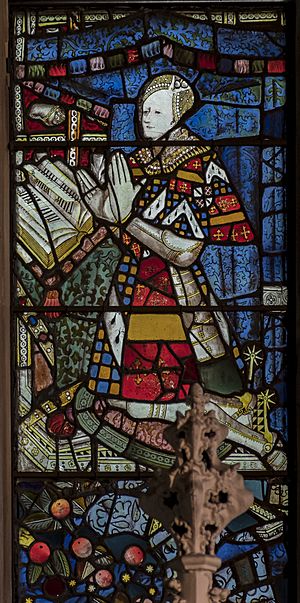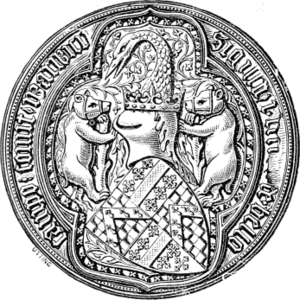Richard Beauchamp, 13th Earl of Warwick facts for kids
Quick facts for kids
Richard Beauchamp
|
|
|---|---|

Drawing of Richard holding Henry VI from the Rous Roll, c. 1483
|
|
| Born | 25 or 28 January 1382 Salwarpe Court, Worcestershire, England |
| Died | 30 April 1439 (aged 57) Rouen, Normandy, France |
| Title | 13th Earl of Warwick |
| Tenure | 8 April 1401 – 30 April 1439 |
| Other titles | Count of Aumale |
| Nationality | English |
| Residence | Warwick Castle |
| Spouse(s) | Elizabeth de Berkeley Isabel le Despenser |
| Issue | With Elizabeth de Berkeley Margaret, Countess of Shrewsbury Eleanor, Duchess of Somerset Elizabeth, Baroness Latimer With Isabel le Despenser Henry, Duke of Warwick Anne, 16th Countess of Warwick |
| Parents | Thomas de Beauchamp, 12th Earl of Warwick Margeret Ferrers |
Richard Beauchamp, 13th Earl of Warwick KG (born 1382, died 1439) was an important English nobleman. He was also a skilled military leader during the Middle Ages. He is known for his bravery and his service to the English kings.
Contents
Early Life of Richard Beauchamp
Richard Beauchamp was born at Salwarpe Court in Worcestershire. His father was Thomas de Beauchamp, the 12th Earl of Warwick. His mother was Margaret Ferrers. King Richard II of England was his godfather. This shows how important his family was.
Richard became a knight when King Henry IV was crowned. In 1401, he took over his father's title. He became the Earl of Warwick.
Fighting in Wales
Soon after becoming Earl, Richard faced a challenge. He had to defend England against a Welsh rebellion. This uprising was led by Owain Glyndŵr. On July 22, 1403, Richard was made a Knight of the Garter. This was a very special award for knights.
In 1404, Richard led English forces into Wales. He fought the Welsh at the Battle of Mynydd Cwmdu. He almost captured Owain Glyndŵr himself. Richard's forces took Owain's banner. The Welsh were forced to run away. However, the Welsh later turned the tables. They chased the English back to the town of Monmouth.
A Knight's Adventures and Travels
Richard Beauchamp became famous for his chivalry. This means he was known for being brave, honorable, and courteous. In 1408, he went on a pilgrimage to the Holy Land. A pilgrimage is a special journey, often for religious reasons. During his trip, he was often challenged to friendly fights. These were sporting combats that were popular back then.
On his way back, he traveled through Russia and Eastern Europe. In 1410, he even tried to join the Teutonic Order. This was a group of warrior monks. He finally returned to England later that year.
Serving the King as a Soldier
In 1410, Richard joined the royal council. This was a group of advisors to the king. Two years later, he was fighting in Calais. By 1413, he was a trusted advisor to Henry V of England. He helped the king put down the Lollard uprising in 1414.
Richard then became the Captain of Calais. He also represented England at important meetings in Europe. One was the coronation of Sigismund as King of Germany. Another was the Council of Constance.
Richard spent many years fighting in the Hundred Years' War against France. He played a big part in battles between 1417 and 1418. He also helped with important talks. He negotiated with French leaders in 1418 and 1419. He was also Henry V's representative for the Treaty of Troyes. This treaty was a major agreement between England and France. Richard led many sieges of French towns between 1420 and 1422.
In 1419, King Henry V made him the Count of Aumale. This was a French title. It was part of the king's plan to give Norman titles to his nobles. Richard was also made Master of the Horse. This was an important role in the royal household.
Important Responsibilities
When King Henry V died, he left a special task for Richard. Richard was given the job of educating the young Henry VI of England. Henry VI was still a baby at the time. This meant Richard had to travel often between England and Normandy.
During these travels, he oversaw the famous trial of Joan of Arc. In 1437, King Henry VI became an adult. Richard's duty as his educator was complete. Even though he was 55 years old, he took on a new role. He became the lieutenant of France and Normandy. He arrived in Normandy in November and ruled with great energy. He stayed in France for the last two years of his life.
Family Life and Children
Richard Beauchamp married twice. His first wife was Elizabeth de Berkeley. They married before October 1397. Elizabeth was born around 1386 and died in 1422. They had three daughters together:
- Lady Margaret de Beauchamp (1404–1467): She married John Talbot, 1st Earl of Shrewsbury.
- Lady Eleanor de Beauchamp (1408–1467): She married Thomas de Ros, 8th Baron de Ros, and later Edmund Beaufort, 2nd Duke of Somerset.
- Lady Elizabeth de Beauchamp (1417–1480): She married George Neville, 1st Baron Latimer, and later Thomas VI Wake.
Richard's second wife was Lady Isabel le Despenser. She was born in 1400 and died in 1439. Isabel was also the widow of Richard's cousin. With Isabel, Richard had two more children:
- Henry de Beauchamp (1425–1446): He became the Earl of Warwick after his father. He later became the Duke of Warwick.
- Lady Anne de Beauchamp (1426–1492): She became the Countess of Warwick after her niece died. She married Richard Neville, 16th Earl of Warwick, who was known as the "Kingmaker."
Death and Final Resting Place
Richard de Beauchamp wrote his will in 1437. He was at Caversham Castle at the time. He left money to the Collegiate Church of St Mary in Warwick. He also asked for a new chapel to be built there. He also gave money to other churches.
Richard died in Rouen, Normandy, on April 30, 1439. This was two years after he wrote his will. After the chapel was finished, his body was moved there in 1475. You can still see his amazing gilt-bronze statue there today. It is a very important piece of 15th-century English art.
Images for kids





